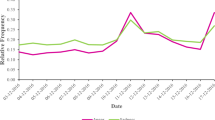Abstract
Emotion is a fundamental object of human existence and determined by a complex set of factors. With the rapid development of online social networks (OSNs), more and more people would like to express their emotion in OSNs, which provides wonderful opportunities to gain insight into how and why individual emotion is evolved in social network. In this paper, we focus on emotion dynamics in OSNs, and try to recognize the evolving process of collective emotions. As a basis of this research, we first construct a corpus and build an emotion classifier based on Bayes theory, and some effective strategies (entropy and salience) are introduced to improve the performance of our classifier, with which we can classify any Chinese tweet into a particular emotion with an accuracy as high as 82%. By analyzing the collective emotions in our sample networks in detail, we get some interesting findings, including a phenomenon of emotion synchronization between friends in OSNs, which offers good evidence for that human emotion can be spread from one person to another. Furthermore, we find that the number of friends has strong correlation with individual emotion. Based on those useful findings, we present a dynamic evolution model of collective emotions, in which both self-evolving process and mutualevolving process are considered. To this end, extensive simulations on both real and artificial networks have been done to estimate the parameters of our emotion dynamic model, and we find that mutual-evolution plays a more important role than self-evolution in the distribution of collective emotions. As an application of our emotion dynamic model, we design an efficient strategy to control the collective emotions of the whole network by selecting seed users according to k-core rather than degree.
Similar content being viewed by others
References
Easterlin R A. Explaining happiness. Proc Nat Acad Sci USA, 2003, 100: 11176–11183
Delamothe T. Happiness. BMJ, 2003, 331: 1489–1490
Kahneman D, Krueger A B, Schkade D, et al. Would you be happier if you were richer? Science, 2006, 312: 1908–1910
Csikszentmihalyi M. Flow: the psychology of optimal experience. Science, 2006, 312: 1908–1910
Wilson T D, Meyers J, Gilbert D T. How happy was I, anyway? A retrospective impact bias. Soc Cognition, 2006, 21: 421–446
Canli T, Sivers H, Whitfield S L, et al. Amygdala response to happy faces as a function of extraversion. Science, 2002, 296: 2191
Gervais M, Wilson D S. The evolution and functions of laughter and humor: a synthetic approach. Quart Rev Biol, 2005, 80: 395–430
Clark A E, Oswald A J. Unhappiness and unemployment. Econ J, 1994, 104: 648–59
Ubel P A, Loewenstein G, Jepson C. Whose quality of life? A commentary exploring discrepancies between health state evaluations of patients and the general public. Qual Life Res, 2003, 12: 599–607
Hatfield E, Cacioppo J T, Rapson R. Emotional contagion. Curr Directions Psychol Sci, 1994, 2: 96–99
Fowler J H, Christakis N A. Dynamic spread of happiness in a large social network: longitudinal analysis over 20 years in the framingham heart study. Brit Med J, 2008, 337: a2338
Yan F, Cai S, Zhang M, et al. A clique-superposition model for social networks. Sci China Inf Sci, 2013, 56: 052113(19)
Pang B, Lee L. Opinion mining and sentiment analysis. Found Trends Inf Retr, 2008, 2: 1–135
Yang C, Lin K, Chen H. Emotion classification using web blog corpora. In: Proceedings of the IEEE/WIC/ACM International Conference on Web Intelligence. Washington DC: IEEE Computer Society, 2007. 275–278
Burges C J C. A tutorial on support vector machines for pattern recognition. Data Min Knowl Discov, 1998, 2: 121–167
Sun C, Mu C, Li X. A weighted LS-SVM approach for the identification of a class of nonlinear inverse systems. Sci China Ser F-Inf Sci, 2009, 52: 770–779
Lafferty J D, McCallum A, Pereira F C N. Conditional random fields: probabilistic models for segmenting and labeling sequence data. In: Proceedings of the 18th International Conference on Machine Learning, San Francisco, 2001. 282–289
Jonathon R. Using emoticons to reduce dependency in machine learning techniques for sentiment classification. In: Proceedings of the ACL Student Research Workshop. Stroudsburg: Association for Computational Linguistics, 2005. 43–48
Frank E, Bouckaert R R. Naive Bayes for text classification with unbalanced classes. In: Johannes F, Tobias S, Myra S, eds. Proceedings of the 10th European conference on Principle and Practice of Knowledge Discovery in Databases. Berlin/Heidelberg: Springer-Verlag, 2006. 503–510
Go A, Huang L, Bhayani R. Twitter sentiment analysis. Final Projects from CS224N for Spring 2008/2009 at the Stanford Natural Language Processing Group. 2009
Zhao J, Dong L, Wu J, et al. Moodlens: an emoticon-based sentiment analysis system for Chinese tweets. In: Proceedings of the 18th ACM SIGKDD International Conference on Knowledge Discovery and Data Mining, Beijing, 2012. 1528–1531
Xiong X, Niu X, Zhou G, et al. Microgroup mining on TSina via network structure and user attribute. In: Proceedings of the 7th International Conference on Advanced Data Mining and Applications-Part II, Beijing, 2011. 138–151
Alvarez-Hamelin J I, Barrat A, Vespignani A. k-core decomposition of Internet graphs: hierarchies, self-similarity and measurement biases. Netw Heterogeneous Media, 2008, 3: 371–393
Carmi S, Havlin S, Kirkpatrick S, et al. A model of Internet topology using k-shell decomposition. Proc Nat Acad Sci USA, 2007, 104: 11150–11154
Pak A, Paroubek P. Twitter as a corpus for sentiment analysis and opinion mining. In: Proceedings of the 7th International Conference on Language Resources and Evaluation, Valletta, 2010
Shannon C E. A mathematical theory of communication. Bell Syst Tech J, 1948, 27
Author information
Authors and Affiliations
Corresponding author
Rights and permissions
About this article
Cite this article
Xiong, X., Zhou, G., Huang, Y. et al. Dynamic evolution of collective emotions in social networks: a case study of Sina weibo. Sci. China Inf. Sci. 56, 1–18 (2013). https://doi.org/10.1007/s11432-013-4892-8
Received:
Accepted:
Published:
Issue Date:
DOI: https://doi.org/10.1007/s11432-013-4892-8




